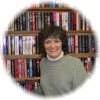TEN HORSE FARM
Pop-up books are so darned much fun it is hard not to love them. Robert Sabuda, the uncrowned king of pop-ups, has a new one: Ten Horse Farm. I almost didn’t even have to open the book to see if I’d like it, after all, my favorite animal is the horse, and my favorite pop-up author is Robert Sabuda.
But I did open it and did read it. Ten Horse Farm consists of nine pages to turn (one descriptive word per page except for the last, and ten horses. The first horse is racing, the second is resting, the third is jumping, the fourth is grazing, the fifth is playing, the sixth is drinking, the seventh is bucking, the ninth is sharing, and the tenth is pulling. The last pop-up illustration is the farm itself with all ten horses and every other animal that shares a place in the book.
The colors are bright, no two horses are the same, and the story, well, the story is so brief you might miss it. If you are the parent, the grandparent, the teacher or the librarian reading Ten Horse Farm to more than one child, you’d best be ready to stay focused on each page for a lot longer than it takes to say the one printed word. The first horse is racing with a dog, but before you can begin to talk about which animal might run faster, your listener(s) will want to open the page over and over herself, just to see how it happens, how does opening the page make the horse run?
Ten Horse Farm is marketed for children from ages 5 to 8 years old. The book contains no flaps to tear accidentally or tabs to pull out. A child in the above age range should be able to turn the pages. There is a lot the reader can add to Sabuda’s magic. Do cats really like to sleep alongside an animal that much bigger than themselves? And what about the horse bucking and the other horse jumping? Do you think those horses are having fun? What else might be fun for a horse?

Horses like to roll around and scratch their backs as fun, too.
Are all the horses back at the farm at the end of the book? Can you see them all? How about the other animals that are in the book? Are they back at the farm, too? I found nine horses easily, but number ten was a little harder to find.
Robert Sabuda is a paper engineer. But he doesn’t drive paper trains. Ten Horse Farm is a chance to introduce young readers to the world of Paper Engineering.
Ann Montanaro explains more of what a paper engineer is: “The paper engineer’s task is to be both imaginative and practical. The designer must determine how movable pieces attach to the page so they won’t break, which points need glue and how much, how long pull tabs should be, and how high a piece can pop up. The final step for the paper engineer is to lay out or “nest” all the pages and pieces so they fit onto the size sheet that will be run through the printing press.
All contemporary pop-up books are assembled by hand, most in Colombia, Mexico, or Singapore. After printing, the nesting pieces of a book are die-cut from the sheets and collated with their pages. Production lines are set up, with as many as 60 people involved in the handwork needed to complete one book. These people fold, insert paper tabs into slits, connect paper pivots, glue and tape. Alignment of tip-on pieces with the printed page must be exact and angles must be precise. The most complex books can require over 100 individual handwork procedures.”
For more information with instructions on how to make your own pop-up book, visit Robert Sabuda’s website. It is a world sure to fascinate readers of all ages, and Ten Horse Farm is an excellent introduction to that world. – Sunny Solomon
Also available by Robert Sabuda: Encyclopedia Prehistorica; Beauty & the Beast; The Dragons & the Knight; Cookie Count; Peter Pan; The 12 Days of Christmas; Winter in White; The Movable Mother Goose; The Wizard of Oz; The Christmas Alphabet; The Christmas Story; The Little Mermaid; Tutankhamen’s Gift; Blizzard’s Robe; Saint Valentine; Mega-Beasts; Gods and Heroes; The White House; The Paper Dragon; Chanukah Lights; America the Beautiful; ABC Disney; Uh-oh. Leonardo!; Help the Animals of Africa; Fairies and Magical Creatures; Help the Animals of North America; Help the Animals of South America; Young Naturalist’s Pop-up Handbook; Alice’s Adventures in Wonderland; Brava Strega Nona!









